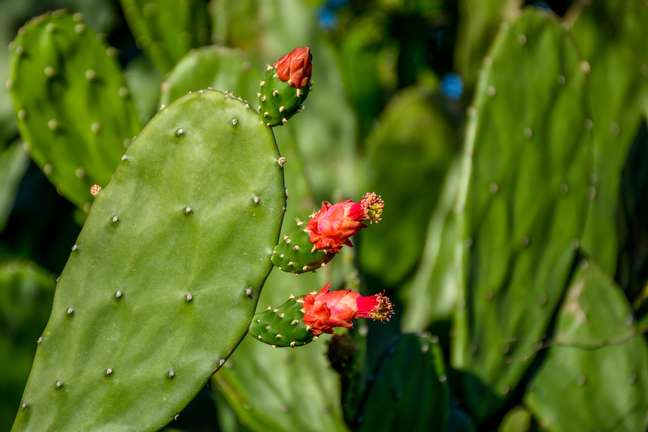Palm, corona de frade, and mandacaru are some of the cacti used in chefs’ recipes, even with a biased market
Immediately it is strange. In addition to thorns, it is generally associated with the driest, driest desert. But the cactusdespite this initial distance, it begins to conquer its space at the tables and on the menus, despite being the subject of a test of the program MasterChef this Tuesday, 21. After all, it may not seem like it, but the cactus can be tasty and make a good accompaniment. No wonder it has already been awarded the United Nations Food and Agriculture Organization (FAO) seal as “food of the future”.

Jucilene Melo has already gone ahead and put the cactus on the menu of the Flor de Mandacaru restaurant. Although the palm tree is the most used in cooking, the chef claims to use all types of cacti found in the caatinga, thanks to its easy access thanks to its location in Chapada Diamantina. This comes from childhood teaching and fond memories. “My childhood was all in the countryside, when I had my first contact with unconventional food plants (PANC), without knowing they had that name”, he says. taste. “My grandmother made sweets from the friar’s crown, from the facheiro. I took it to Flor.”
Today Flor de Mandacaru, in Petrolina, treats the cactus as a base. In addition to the “corona de frade” candies, from Jucilene’s grandmother, the menu also includes minced palm meat, mandacaru pickles, which can be served sweet or savory, and sometimes the moqueca with berries. And although the plant is common in some places, such as Mexico and in Chapada Diamantina itself, there is still a difficult way to spread it. “It’s an anthill, a fight,” says Jucilene. “But there are already people from the South who are curious to try it”.
Benefits of cactus in food

Obviously, this movement of inserting the cactus into the diet does not happen without reason and, around its use in gastronomy, there are a series of benefits. First, for example, there are the handling and planting facilities. “The fodder palm, for example, came here to feed livestock. It is very easy to plant, to grow,” he explains. Neide Rigochef, nutritionist and author of the book Table of meals in the semi-arid. “I myself have the palm of my hand here at my window. It’s really easy to have food around, no complications.”
The only challenge that requires more attention is preparation. It is necessary to use a very sharp knife to remove the bark with the thorns, always with a glove on your hands to protect yourself from any accidents. Afterwards, it is recommended to wash the cactus to make sure there are no thorns.
After that, however, only positive things. Cacti are also high in calcium and protein, which help supplement your diet. And the best: in addition to all these benefits, it is a delicious food. “Each cactus has a specific taste,” explains Jucilene Melo, when asked how the cactus reaches people’s palates. “Some have a really herbaceous flavor, others have the flavor of green papaya. Some have mistletoe, a drool like okra. Frade’s crown, for example, is more reminiscent of this green papaya, while mandacaru is neutral.”
Ieda de Matos, from Casa de Ieda, in Pinheiros, he also loves cacti. On its menu, the most common recipe is the Corta de Palma, a simple stew made with pork belly and that very fat that the chef’s mother, Dona Dalva, calls fat. He has also made several recipes such as “palmuru” – that is, a pigeon pea that uses palm instead of okra. He also made the palm-roasted pamonha. “With creativity, we can create simple and sophisticated recipes,” he says. “Cacti are conductors of flavors.”
Cactus and the challenge of prejudice
Despite all these advantages and the good uses that gastronomy make of it, the cactus still faces a barrier: prejudice. “Many people ate the cactus in times of scarcity, of hunger. Therefore, even in regions such as the Northeast, which has an older custom and a stronger presence than the cactus, there is still the prejudice on daily use, in gastronomy There is a fear of putting this food on the table “, contextualizes Neide Rigo. “We have to extrapolate, look out and see that this is a food like any other”.
Today Ieda de Matos sees the use of the cactus in the kitchen as an act of resistance, having to find a way to make the plant “survive”. “We have a hard time finding this ingredient here in São Paulo. Therefore, we’ve partnered with Mexican restaurants to get the palm. Our role is to spread these ingredients and show their potential,” he says. “I fight so that the use of the cactus does not become extinct in our food culture”.
Source: Terra
Benjamin Smith is a fashion journalist and author at Gossipify, known for his coverage of the latest fashion trends and industry insights. He writes about clothing, shoes, accessories, and runway shows, providing in-depth analysis and unique perspectives. He’s respected for his ability to spot emerging designers and trends, and for providing practical fashion advice to readers.




![A more beautiful life in advance [SPOILERS] A more beautiful life in advance [SPOILERS]](https://fr.web.img2.acsta.net/img/90/2d/902d777a1341c7bc0507675575d75b53.jpg)


